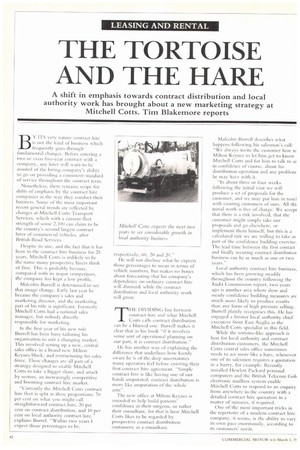THE TORTOISE AND THE HARE
Page 42

If you've noticed an error in this article please click here to report it so we can fix it.
A shift in emphasis towards contract distribution and local authority work has brought about a new marketing strategy at Mitchell Cotts. Tim Blakemore reports
BY ITS very nature contract hire is not the kind of business which frequently goes through fundamental changes. Before entering a two or even five-year contract with a company, any hirer will want to be assured of the hiring company's ability CC) go on providing a consistent standard of service throughout the contract term.
Nonetheless, there remains scope for shifts of emphasis by the contract hire companies in the way they conduct their business. Some of the most important recent general trends are reflected by changes at Mitchell Cotts Transport Services, which with a current Beet strength of sonic 2,100 can claim to be the country's second largest contract hirer of commercial vehicles. after British Road Services.
Despite its size, and the fact that it has been in the contract hire business for 25 years, Mitchell Cutts is unlikely to be the name many prospective hirers think of first. This is probably because, compared with its major competitors, the company has kept a low profile.
Malcolm Burrell is determined to see that image change. Early last year he became the company's sales and marketing director, and the marketing part of his title is significant. Formerly Mitchell Cotts had a national sales manager, but nobody directly responsible for marketing.
In the first year of his lieW role Burrell has been busy tailoring his organisation to suit a changing market. This involved setting up a new, central sales office in a brand new Milton' Keynes block, and restructuring his sales force. These changes are all part of a strategy designed to enable Mitchell Cotts to take a bigger share, and attack by sectors, an increasingly competitive and booming contract hire market.
"Currently the Mitchell Cons contract hire fleet is split in these proportions: 70 per cent on what you might call straightforward contract hire, 20 per cent on contract distribution, and 10 per cent on local authority contract hire." explains Burrel. "Within two years I expect those percentages to be, respectively, 60, 20 and 20."
He will not disclose what he expects those percentages to mean in terms of vehicle numbers, but makes no bones about forecasting that his company's dependence on ordinary contract hire will diminish while the contract distribution and local authority work will grow.
THE DIVIDING line between contract hire and what Mitchell Cotts calls contract distribution can be a blurred one. Burrell makes it clear that in his book "if it involves some sort of operational planning on our parr, it is contract distribution."
He has another way of explaining the difference that underlines how keenly aware he is of the deep uncertainties many operators feel before entering their first Contract hire agreement. "Simple contract hire is like having one of Our hands amputated, contract distribution is more like amputation of the whole arm".
The new office at Milton Keynes is intended to help build patients' confidence in their surgeon, or rather their consultant, for that is how Mitchell Cotts likes to be regarded by prospective contract distribution customers; as a consultant. Malcolm Burrell describes what happens following his salesman's call: "We always invite the customer here tc Milton Keynes to let him get to know Mitchell Cotts and for him to talk to tu in confidence of course, about his distribution operation and any problem he may have with it.
'In about three or tour weeks following the initial visit we will produce a set of proposals for the customer, and we may put him in toucl with existing customers of ours. All thi initial work is free of charge. We accept that there is a risk involved, that the customer might simply take our proposals and go elsewhere, or implement them himself, but this is a calculated risk we are willing to take as part of the confidence building exercise. The lead time between the first contact and finally securing contract distributioi business can be as much as one or two years.'' Local authority contract hire business, which has been growing steadily throughout the country following the Audit Commission report, two years ago is another area where slow and steady confidence building measures arc much more likely to produce results than any form of high pressure selling. Burrell plainly recognises this. He has engaged a former local authority chief executive from East Anglia as the Mitchell Cotts specialist in this field.
While the tortoise-like approach is best for local authority and contract distribution customers, the Mitchell Cotts central sales office sometimes needs to act more like a hare, whenever one of its salesmen requires a quotation in a hurry, for example. Recently installed Hewlett Packard personal • computers and the British Telecom Colt electronic mailbox system enable Mitchell Cotts to respond to an enquiry from anywhere in the country with a detailed contract hire quotation in a matter of minutes, if required.
One of the most important tricks in the repertoire of a modern contract hire company, it seems, is die ability to vary its own pace enormously, according to its customers' needs.




























































